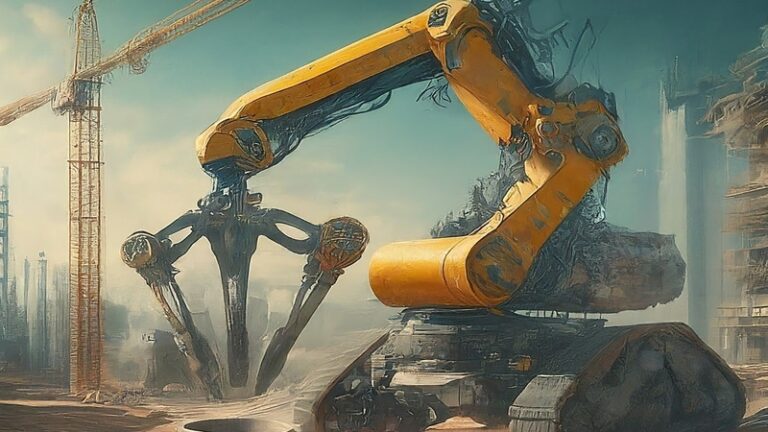Traditionally characterized by manual labor, heavy machinery, and often lengthy timelines, the construction industry could benefit immensely from automation. The shift to automation would not merely be a luxury or a trend but a necessity driven by a confluence of factors that demand a fundamental reimagining of how we build.
In this article, we’ll discuss the potential for automation in construction and how close we are to realizing that potential in 2024. We’ll explore opportunities for automation and give an overview of the expected benefits and pitfalls.
Automation Can Significantly Improve Productivity
Automation has revolutionized manufacturing and agriculture, showcasing its transformative potential across diverse sectors.
agriculture has enabled precision farming with autonomous tractors and drones, optimizing yields while minimizing resource use and environmental impact.
According to McKinsey, between 1947 and 2010, productivity in agriculture in the United States increased by a factor of 16, while productivity in manufacturing increased by a factor of eight. Automation was a huge contributor to these increases in productivity.
Comparatively, productivity in construction barely changed in the same time frame. This comes as no surprise — the construction industry has been lagging behind in adopting automation.
A question arises: What does successful automation in the construction industry look like?
The Promise of Automation in the Construction Industry
The need for automation in the construction industry is multifaceted and compelling. First and foremost, it addresses the pressing issue of efficiency.
Enhanced Productivity
Time delays and cost overruns have long plagued construction projects, impeding progress and draining resources. Automation promises to streamline processes, optimize workflows, and minimize human error, thereby enhancing productivity and ensuring projects are completed on time and within budget.
A Solution to Labor Shortages
Furthermore, automation holds the key to addressing the chronic labor shortages that have become endemic to the construction sector.
With an aging workforce and a dwindling pool of skilled laborers, the industry is facing a looming crisis. By deploying robotics, artificial intelligence, and other automated technologies, construction companies can mitigate the impact of labor shortages, reduce reliance on manual labor, and augment existing workforce capabilities.
Improved Safety
Moreover, automation offers unparalleled safety benefits. Construction sites are inherently hazardous environments, where accidents and injuries are all too common.
By automating repetitive and dangerous tasks, such as heavy lifting and working at heights, companies can minimize the risk to workers and create safer work environments.
Better Quality Assurance
Automation in construction can also enhance quality assurance by employing advanced technologies such as sensors, drones, and AI-powered inspection systems.
These technologies enable real-time monitoring of construction processes, identifying defects or deviations from standards immediately. By automating inspections and quality control tasks, construction companies can ensure consistency, accuracy, and compliance with specifications, ultimately leading to better-built structures with fewer defects or errors.
With the above potential gains, the adoption of automation in construction would be a dream come true. But just how close, or far, are we from this dream in 2024?
Game-Changing Automation in Construction: How Far Are We in 2024?
The effects of automation have never been so pervasive. From the revolution of information consumption through Chat-GPT and similar artificial intelligence (AI) inventions to the introduction of self-driving vehicles on roads, the age of automation is here.
With virtually every industry being affected by automation, what strides has the construction industry made?
Automation of On-Site Physical Tasks
One of the opportunities for automation in construction is on the construction sites. There are multiple, labor-intensive tasks, like brick-laying and excavation, that could be automated.
However, the automation of such tasks presents unique and difficult challenges.
Take excavation as an example. It’s a dynamic process that takes place in a constantly evolving environment. In contrast, automation thrives when there’s a repetitive task being performed in a fairly constant environment, like picking bottles off a conveyor belt.
Caterpillar, an industry leader in construction equipment, began exploring autonomous excavation trucks in the 1990s. By 2023, the company had yet to commercialize automated excavators for construction.
Another intractable challenge is that certain construction tasks require levels of dexterity that are relatively easy for humans but extremely difficult for robots.
Overall, though there’s some progress being made towards the automation of on-site construction tasks, we’re still a long way from the sort of widespread automation that would be game-changing.
Automation in Modular Construction
If you can’t automate tasks on the construction site, a workaround may be to make modules at a factory and ship them to the site. It’s easier to keep things constant in a factory, which makes it a more friendly environment for automation.
In theory, the system is perfectly workable:
- You receive a model
- You optimize for modular construction from the beginning
- You automate the pre-fabrication process in a factory
- You ship the complete modules and assemble them on-site
You’ll have sidestepped the challenges of on-site automation, and you’ll enjoy the benefits of automation, such as increased productivity.
Unfortunately, large-scale modular construction remains elusive. Katerra, a US startup that operated from 2015 to 2021, failed to achieve the utopia of full-scale modular construction despite $3 billion in investor funding.
Still, there’s progress. Hyperframe is reinventing the wheel when it comes to steel framing. They claim to make the steel framing process 15 times faster. And they’re using factory automation to help them achieve this.
Automation of Design, Planning, and Management
By far, this is the construction area that has experienced the greatest automation success.
The design, planning, and management of construction can be automated through the use of Building Information Modeling (BIM) software, project management software, and AI-driven tools.
Design
BIM software allows architects and engineers to create digital models of buildings and infrastructure, facilitating collaboration, visualization, and analysis throughout the design process.
Planning
Project management software automates scheduling, resource allocation, and task tracking, streamlining project planning and ensuring efficient use of resources.
Management
AI-driven tools can analyze data from sensors and project management systems to optimize workflows, identify potential risks, and make real-time decisions, enhancing project management efficiency and effectiveness.
How Construction Estimating Software is Leading the Construction Automation Revolution
Construction estimating software uses advanced algorithms and databases to generate accurate estimates for materials, labor, equipment, and other project expenses.
By automating the estimating process, construction companies can significantly reduce the time and effort required to produce cost estimates, while also improving accuracy and consistency. This automation enables faster decision-making during project planning and bidding processes, allowing companies to competitively price their services and win more contracts.
Moreover, construction estimating software often integrates with other project management and accounting systems, facilitating seamless communication and data sharing across different stages of the construction project lifecycle. This integration further enhances efficiency and enables better decision-making by providing real-time insights into project costs and progress.
Frequently-Asked Questions
How is automation affecting the construction industry?
Automation is gradually boosting efficiency and productivity in the construction industry. Though game-changing advances have yet to be realized in both on-site automation and modular construction automation, the planning and management aspect of construction is undergoing an automation-fuelled revolution.
Why is automation important in the construction industry?
Automation is important in the construction industry because it could potentially enhance productivity, improve efficiency, address labor shortages, increase site safety, and drive innovation, ultimately leading to better-built structures and more sustainable construction practices.
What is the scope of automation in the construction industry?
The scope of construction automation can be divided into three:
- The automation of on-site construction tasks like brick-laying and welding
- The automation of off-site modular construction
- The automation of the planning, design, and management of construction
What is the future of robotics in the construction industry?
The future of robotics in the construction industry holds promise for increased automation in tasks such as bricklaying, welding, demolition, and site inspection, leading to enhanced productivity, efficiency, and safety on construction sites.
What are the challenges of construction automation?
The challenges of construction automation include:
- The demanding dexterity requirements of certain construction tasks
- Initial investment costs
- The dynamic nature of construction sites, which doesn’t augur well with automation
- Integration with existing processes
- Workforce retraining
- Cybersecurity risks
- Potential resistance to change within the industry















